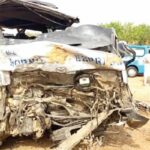
THIS is not the first time that an oil spill is happening in the Niger Delta. In fact, oil spills are a common event there; but this particular incident that occurred in Nembe at the end of 2021 is outrageously alarming. The government, the oil firm and the entire people of Nigeria have no excuse for allowing the traumatised people of Nembe to continue wallowing in their misfortune without any reasonable intervention to help them survive the hazard, which of course is no fault of theirs. Their only crime is being born in the ecosystem of the Niger Delta – a once beautiful terrain, now brutalised and degraded by crude oil exploration and exploitation.
An oil spill is the release of a liquid petroleum hydrocarbon into the environment, especially the marine ecosystem, due to human activity. It is a form of pollution. It may be due to releases of crude oil from tankers, offshore platforms, drilling rigs and wells, as well as spills of refined petroleum products (such as gasoline, diesel) and their by-products, heavier fuels used by large ships such as bunker fuel or the spill of any oil refuse or waste oil.
November 1, 2021 was a dark day for the residents of Nembe communities of Bayelsa State. On that day, a devastating blowout occurred at the Santa Barbara South Well 01 around the Oil Mining Lease 29 operated by Aiteo Exploration and Production Company and desecrated their ecosystem. For 38 consecutive days, the affected facility consistently shelled crude oil into the tidal and ebbing waters before it was eventually stopped on December 8. It is estimated that over two million barrels of crude oil were spilled into the ecosystem from the affected facility.
At least, about 45 communities and fishing settlements, including Worikuma-kiri where the OML 29 well 01 is located, were gravely impacted by the industry-induced environmental catastrophe. The spewed crude soaked the expansive mangrove swamp and farmlands while depositing a huge presence of hydrocarbon around the Santa Barbara River and adjoining creeks and rivulets, thereby polluting the fibrous mangrove roots. It has, significantly, wiped out aquatic lives such as periwinkles, oysters, fishes, crabs, crayfish, among others. Also, fishing traps and nets set at strategic locations by fishermen and women before the spill occurred were soiled and destroyed by the heavy presence of crude, which impacted the people’s livelihood.
The residents of the ancient Nembe kingdom are predominantly farmers and fishermen and women. This means that the marine environment and its exotic mangrove swamp mean everything to them. Over the decades, they have depended wholly on it for their survival. And in these modern times, their local economy still thrives on the marine environment, spread out like a green carpet on the fringes of the Atlantic Ocean. Therefore, this Aiteo oil spill has sounded a death knell for the people and their natural habitat.
Although there were some motions here and there, and in some quarters, immediately after the incident, today, four months down the line, we have yet to see any remarkable plan of action to put the people of Nembe back on the path of recovery and also remediate their damaged environment.
The cycle of doom in the Niger Delta is now upon the people of Nembe. It starts with the discovery of crude oil. Then the company inserts its pipe and starts to drill. It evacuates the abundant resources and smiles to the banks. Then a small glitch occurs—either through its operation equipment, sabotage or corrosion in the pipes—and oil spill occurs. The environment is devastated. The company panics, packs up and scampers to safety. The government lazily surfaces to count the dead, releases a press statement threatening fire and brimstone, with no concrete action. The company creeps back to the creeks after some days to deliver some food items and empty words of hope to the hapless local people. They take off again. For good. And life goes back to normal, for everybody except the unlucky Niger Deltans.
This time around, the guilty company, Aiteo oil exploration and production company, happens to be an indigenous company and that makes it even worse for the impacted Nembe community. After it mobilised to Opu-Nembe and donated foodstuff and other relief items, it has not shown any other visible signs of remedying the damage. Now, the Nembe community people are reeling in angst and anguish. There is no fish in the water; no green on the land; no joy in the air. They feel deserted by the federal and state governments, as well as the indigenous oil firms that ordinarily would have shown more empathy than foreign ones.
The worst part of the story is that the victims were not even evacuated to Internally Displaced Persons camps where their health needs would be attended to. They are left to inhale the toxic stench from the crude oil that has encrusted their land like a grip of liquid death. Even in theatres of war and insurgency, victims are first ferried to safe ground but not in Nembe. Are we waiting for an epidemic to break out, and people start dropping dead, before we do the needful?
To be sure, there are reports that people, especially those who have remained in the area since the spill, began to develop difficulty in breathing. Methane, a greenhouse gas, is a main component of natural gas that the wellhead was spewing alongside crude oil for weeks. At high concentrations, methane exposure can lead to poisoning and when inhaled cause less oxygen required to breathe. Methane inhalation can lead to acute respiratory conditions. Yet, these despairing Nembe folks prefer to stay put in their polluted enclaves because they have no other place to take refuge in.
More troubling is the impact on their physical environment. Hydrocarbon pollution on water makes oil cover the surface of the water, thereby blocking oxygen exchange and causing death of fishes. In addition, residents testify that their rainwater has had “charcoal-like” colour since the spill. Residents of the affected riverine communities had always depended on rains to make the river water fresh and usable for consumption because during dry seasons the water could be very salty. This could then mean that the hydrocarbon pollution of their environment (from the oil spill) may have adversely affected precipitation.
It seems our national story is a tale of injustice. Petroleum from the Niger Delta has been the main source of Nigeria’s foreign exchange and revenue since the 1970s. But the region has suffered neglect and most of the rural communities, like those around Santa Barbara River where oil is actually produced, barely enjoy any human capital enhancement services, including potable water infrastructure, education and healthcare facilities. Plus, when the spill occurs, they are left to die in silence. This is a sad note on our democracy.
The Nigerian National Petroleum Corporation places the quantity of petroleum jettisoned into the environment yearly at 2,300 cubic metres (19,000 US bbl) with an average of 300 individual spills annually. However, because this amount does not take into account “minor” spills, the World Bank argues that the true quantity of petroleum spilled into the environment could be as much as ten times the officially claimed amount. The Department of Petroleum Resources estimated that 1.89 million barrels of petroleum were spilled into the Niger Delta between 1976 and 1996 out of a total of 2.4 million barrels that spilled in 4,835 incidents.
Copyright PUNCH.
All rights reserved. This material, and other digital content on this website, may not be reproduced, published, broadcast, rewritten or redistributed in whole or in part without prior express written permission from PUNCH.
Contact: [email protected]





